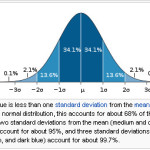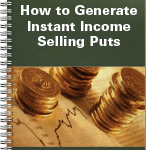Hey Michael!
I wanted to fill you in on something I have been playing with recently.
In February I used my margin account to buy 100 shares of ETF QQQ. [Ed note: This ETF tracks the tech-heavy Nasdaq 100 index.] Then immediately I sold a 1-day call at the next dollar value up and a 1-day put at the next dollar down price. If forced to buy, I immediately turn around and sell a 1-day call at what I think is a reasonable price. If all my shares were “called away”, I would simply sell puts. I have made $14,784 (cash, not paper profits) in just over 6 months without using a penny of my own money. This total includes capital gains/losses, put premiums, call premiums, and margin interest charged. I understand that if I had just bought and held the original 100 shares, I would have made $6,200 profit on paper. That pales when compared with what I have done. And also, I don’t research or try to outsmart anything. It takes about 3 minutes a day and is pretty mindless.
Obviously, it has been a wonderful market for 6 months, and I’m not suggesting you write about this for the general public. I just thought you might find it interesting and would welcome your thoughts. Even in a down market, it would create an income stream of about $100 a day in cash (even with paper losses) to pay bills etc.
If I ever got overloaded with too much QQQ due to exercised puts (i set my limit at 300 shares or about $135,000 on margin), I would stop selling puts.
I would love to see an article about my basic investing strategy of using put and call ladders on strong ETFs to force me to sell at high prices and buy at low, while creating an income stream and boosting yields.
Gerard van den Dries, San Antonio, TX
Thanks for staying in touch Gerard, and for your most recent idea, writing about short-dated options. I am particularly grateful because since early 2023 1-day option trading – also known as 0dte (short for “zero days to expiration”) – has dramatically surged among retail traders. Whereas short-dated options were only about 20 percent of options trading volume until 2022, it now makes up 45 to 50 percent of the options trading on stocks. Regulators have taken notice, and frankly they are worried. The former SEC Chairman Jay Clayton has called “0dte options” gambling, and thinks they should not be allowed.
To briefly review options terms: When you sell a 1-day put, that means your broker has the right to sell you that ETF, which they only do if it drops in value over that day. When you sell a 1-day call, that means your broker has the right to buy the ETF from you, which they only do if it goes up in value over that day.

I have lots of thoughts on options-trading as a strategy, a business I used to be involved in on the brokerage side as an institutional bond salesman.
Before I get into my actual reaction, it’s worth acknowledging the advantages you cite:
1. You are only spending 3 minutes a day on it and not doing any research, which implies many could use this same strategy to profit.
2. Your investment returns have been well over twice what they would have been if you just bought and held the same ETF.
3. You have created a system by which, because of the forced buying and selling, you will automatically buy low and sell high, which is highly enviable.
4. Finally, you are using borrowed money, so you don’t have to put up money in advance, an attractive feature as well.
Ok, on to my views of this as a strategy, both for you in particular and for the people who are participating in this massive surge in 0dte trading we’ve witnessed in recent years.
Your experience has been very positive and profitable. But in no way would I endorse this.
Risk Profile
I think the risk you are taking when you sell options has the profile of an insurance company. That is to say, you take in small premiums most days, earning the steady income you like. Then, every once in a while, a big move happens and you have the potential to lose big.
This works in the insurance industry best (and is ultimately survivable only) with unlimited funds relative to the size of the bets.
A sudden downward move, or multiple down days, could leave you owning a lot of QQQ with losses on your ownership. It is good that you have a limited size of QQQ beyond which you wouldn’t purchase more or write additional put options. Investment returns will also be magnified, for good and evil, when you buy on margin.
A structural problem of you earning premiums like an insurance company is that your broker is buying the insurance from you. They have the computing power to price this attractively for them, over the long run. You should not assume they are mispricing the insurance they are buying from you.
I’m not saying you should never do this. Based on our previous conversations, I know you have a very conservative approach to spending, and you’ve very likely accumulated sufficient investment capital that allows you to take a gamble. I would just say emphatically that this is a gamble, in a way that boring old buy-and-hold can feel like a gamble in the short run but in the long run is an investment. With options trading, there is no long run. It’s only a series of short-run gambles. I believe that in the long run and on average, options trading like this will not lead to gains. The primary winner will be the firm that bought insurance from you.
I acknowledge that has not been your experience so my advice doesn’t match up with your observed profits.
Market environment
I fear that this strategy works well in particular market environments, and not others. The ideal environment for covered-options selling is steady and upward trending. Which is mostly what we’ve had in 2024.
The first two days of August however started with the Nasdaq 100 down about 5 percent. It’s that kind of action, especially if it continues, which can lead someone to get wrecked.
We generally won’t know when we’ve shifted from one phase (steady and upward trending) to the other phase (volatile and downward trending) until it’s already happened to us.
Options trading in general
As a general rule, I can’t endorse retail – meaning non-professional – options trading.
Certain options strategies, like selling uncovered calls, have unlimited losses as a possibility. You have limited your risk there by owning the underlying QQQ before you sell a call, which is good. Other options strategies, like selling puts, also have nearly 100% loss-of-principal possibilities. You limit your risk there by keeping your bet sized appropriately. Purchasing calls and puts that expire worthless also have the possibility of 100% loss of investment. Unlike buy and hold investing, options trading is always a short-term and zero-sum gamble.
Short-term gambles can be fun. I play poker with the neighborhood dads. I even periodically make a pilgrimage to Las Vegas to lose sums larger than I can efficiently lose to the neighborhood dads. But I distinguish my fun gambles from good investment strategies.
From other conversations we have had, and since you personally limit the size of your gambles, I think you will be fine. I just would not recommend this as a general strategy for most people to pursue.
A version of this ran in the San Antonio Express News and Houston Chronicle.
Please see related post
Post read (65) times.







